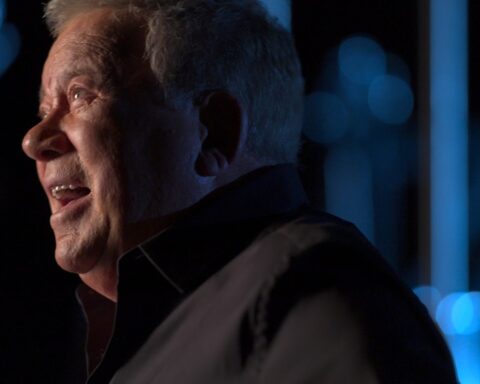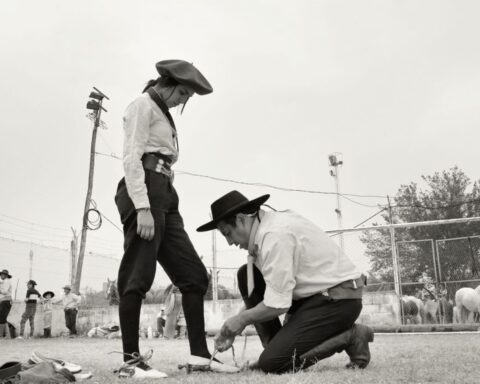Hitchcock/Truffaut
USA, 80 min.
Dir Kent Jones
Programme: TIFF Docs (Canadian Premiere)
“There is no terror in the bang,” Alfred Hitchcock once said, “only in the anticipation of it.” Fans of The Great Director will experience the signature thrill of anticipation one enjoys in a Hitchcock film with Kent Jones’s cinematic documentary Hitchcock/Truffaut. It’s an amicable cousin to this year’s other conversational doc Best of Enemies, which revisits the 1968 televised political debates between William F. Buckley, Jr. and Gore Vidal. Instead of the ferocity offered by the intellectual near pugilists Buckley and Vidal, Jones’ doc offers a supportive series of intelligent conversations between Hitchcock and director François Truffaut, which explores each of Hitchcock’s films. Their interviews, published in the book Hitchcock/Truffaut, are a film school staple and a cornerstone text for expanding the auteur theory beyond the pages of Cahiers du cinema and into the larger cultural dialogue surrounding film studies. Hitchcock/Truffaut, the movie, expands upon this dialogue by using the book as a springboard for a broader conversation on Hitchcock’s oeuvre with current auteurs whom his work inspired. It’s a treat for film buffs.
Jones assembles an impressive cast of talking heads to discuss Hitchcock’s technique, style, and legacy in a contemporary extension of the Hitchcock/Truffaut chats. Martin Scorsese, David Fincher, Paul Schrader, Wes Anderson, Arnaud Desplechin, and Olivier Assayas speak to both sides of the Hitchcock/Truffaut legacy by situating the films in their place in time and talking about the effect that the films had on their own careers.
It’s not a master class for all filmmakers, though, as the roster of talking heads unfortunately, if unintentionally, reflects the lack of diversity within the canon of auteur filmmakers. Hitchcock/Truffaut doesn’t feature a single female filmmaker in the conversation—where are Jane Campion, Kathryn Bigelow or Claire Denis?—and the film inevitably glosses over the gender gaps that characterise much of Hollywood, including Hitchcock’s work. The film briefly acknowledges Alma Reville’s relatively unsung role in Hitchcock’s filmography and simplifies traits of Hitchcock’s own work that reveal an uncomfortable element of sexism.
Take, for example, Hitchcock’s notorious disinterest in Vera Miles after her pregnancy, which made her unavailable for the lead role in Vertigo. This element receives an intriguing mention in the sequence in which the filmmakers analyse Vertigo and note Hitchcock’s choice of point of view that favours the male perspective and several of the directors say they wish that the film looked deeper into the mind of its female lead, played by Kim Novak. The directors, however, reflect upon this artistic choice with reverence: Hitchcock/Truffaut doesn’t question the director’s decisions; it simply praises them. Ever the great director, the filmmakers elaborate how Hitchcock’s fondness for ogling blondes with the camera’s eye adds a deliciously implied sinfulness to his films.
Hitchcock/Truffaut nevertheless offers some of the best film analysis one can find in a documentary as Jones juxtaposes Truffaut’s interviews with those of the assembled directors. Hitchcock’s technical craft is obvious and it’s easy to see why he still carries the moniker of “Master of Suspense” as the directors collectively analyse time, space, suspension of disbelief, and other elements that make Hitchcock films a brand of their own. The film largely favours Hitchcock over Truffaut, so fans of the French New Wave might be disappointed, but Truffaut wasn’t the subject of the interviews: Hitch was. Hitchcock/Truffaut doesn’t actually offer much footage from the landmark interviews, but the excerpts and snippets of correspondence between the two masters keeps their voices in the conversation throughout the film.
Perhaps the most striking debate in the film is the analysis of Hitchcock’s fondness for high angles. Close analysis of an aerial shot of birds swarming Bodega Bay in The Birds or a high angle shot of Martin Balsam ascending the stairs to his death in Psycho invite Scorsese and company to suggest a strong religious overtone in Hitchcock’s work. A slasher film might not be the place one expects to find God, but the filmmakers read Hitchcock’s shot choices as a means of injecting the point of view of a higher power into the film. The effect, they say (and quite convincingly so), is to transfer a sense of guilt from the onscreen character to the viewer. Hitchcock’s films prey upon the collective insecurities of the audience, and these ominous viewpoints play exactly into fears of celestial judgement and doom.
Hitchcock/Truffaut considers Hitchcock’s background in silent film as the directors elaborate on continual changes in the industry, such as the explosion of television, through which Hitchcock not only persevered but expanded his appeal with a successful weekly show. They illustrate how his manipulation of the aesthetics of the medium have made his work timeless, such as his favouring visual impressions over dialogue—the difference between “showing” and “telling”—and his ability to radically shake expectations as he did in the release of Psycho.
Psycho, arguably the biggest game-changer that Hitchcock introduced to the film industry with its unconventional pacing, shifts in point of view, unanticipated violence, and spectacularly eccentric release, receives the best treatment in the film as Jones visits snippets of the Hitchcock/Truffaut interview in-between extended excerpts of the film. The shot-by-shot analysis of the famous shower scene is a true master class for any cinephile as great directors affectionately articulate the masterful craftsmanship that makes the scene so unnerving. Only Vertigo and The Birds receive equally strong and full analysis in the film as Jones moves very quickly through Hitchcock’s prolific filmography. Some of his best works, like Rebecca (his only film to win the Best Picture Oscar), Rear Window, Rope, and Lifeboat barely receive a mention. Similarly, Jones omits Hitchcock’s lesser efforts, such as his obscure 1934 musical Waltzes in Vienna. Hitchcock’s filmography and Truffaut’s book both have enough material for a longer and more substantial film. A second semester of film studies à la Hitchcock/Truffaut would be most welcome.
Hitchcock/Truffaut had its Canadian Premiere at the 2015 Toronto International Film Festival. Please visit www.tiff.net for more information on this year’s Festival.
Update: Hitchcock/Truffaut screens in Toronto at TIFF Bell Lightbox on July 9 with an introduction by Kent Jones as part of the summer series Hitchcock/Truffaut: Magnificent Obsessions.










